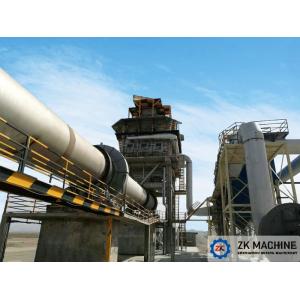Henan Zhengzhou Mining Machinery Co., Ltd (hereinafter referred to
as “ZK”)., founded in 1956, is a designated production unit of
building materials and mining machinery designated by the National
Ministry of Machinery Industry and Henan Provincial Department of
Machinery and Electronics Industry. After more than 60 years of
development, our company has gradually developed from a single
mechanical equipment manufacturing enterprise into a comprehensive
company with strong ability of the whole system researching and
designing on process technology and equipment manufacturing in the
fields of building materials, mining, metallurgy, environmental
protection etc.
After more than 60 years of development, it has gradually developed
from a single mechanical equipment manufacturing enterprise into a
high-tech enterprise which is integrating scientific research,
engineering, manufacturing, installation, commissioning and
operation guarantee, with a net asset of more than 200 million RMB.
Now, Henan ZK Corp already has been growing up to a comprehensive
company with strong ability of the whole system researching and
designing on process technology and equipment manufacturing in the
fields of building materials, mining, metallurgy, environmental
protection etc.
The company is located in Qiaolou Caizhai Industrial Zone, West 5th
Ring Road, Zhengzhou City, covering a land area of more than 80000
m2, with workshop area of more than 60000 m2, and office area of more than 5000 m2. There are 6 modern workshops, 5 heavy workshops, equipped with
the largest boring and milling machine, gear hobbing machine,
vertical lathe, crane and other heavy equipment in Zhengzhou
region, and more than 300 sets of manufacturing equipment. This
enables us to independently complete the process system and
large-to-medium equipment manufacturing. ZK has its own process
experimental workshop, and testing & analysis center, capable of
conducting pilot tests and data analysis for solid waste and
hazardous waste treatment, building materials, metallurgical
materials etc. These facilities allow us to provide process
package, provide strong engineering and technical support for
project engineering and construction, and ensure the successful
execution of customer projects.
ZK Zhengzhou Office is located in the Science and Technology Park
of National University, the West Third Ring Road of Zhengzhou City,
which includes the Oversea Business Department, E-commerce
Department, Domestic Business Department, R&D Center, with an
office area of more than 1500 m2. In recent years, our oversea business has been covering more than
100 countries and regions in the world, and our domestic business
has been covering all provinces and regions in China. We have
established long-term good cooperation with many large and
medium-sized enterprises at home and abroad. Our E-commerce
Department has built our company into a "Henan E-commerce
Demonstration Enterprise"; Our R&D Centre includes “Zhengzhou
Municipal Enterprise Technology Center” and “Industrial Solid Waste
Disposal Equipment Engineering Technology Research Centre”, which
already formed a reasonable technical echelon of scientific
researchers from undergraduate to doctor, from technician to senior
engineer. Our R&D Centre already has had the EPC contracting
ability to independently complete the whole set of process system
and equipment researching and designing in many process technology
and equipment manufacturing fields.
Our main process system products includes:
1.Environmental protection process for:
Hazardous Solid and Waste Solid Treatment (sludge, shale, chrome
mud, red mud, fly ash, coal gangue, etc.), Dedusting and Flue Gas
Purification etc.;
2.Building materials process for:
Light Expanded Aggregate (LECA), Ceramsite Sand, Oil Fracturing
Proppant, Refractory, Powder, Lime, Cement Production etc.;
3.Mineral processing process for:
Iron Ore, Bauxite Ore, Kaolin, Copper Ore, Lead & Zinc Ore, Gold
Ore, Fluorite Ore, Graphite Ore etc.;
4.Metallurgical process for:
Metal Magnesium Production Process (Calcination, Pelletizing,
Reduction, and Refining);
5.Calcination/Sintering Process for :
Dolomite, Limestone, Magnesite, Bauxite, Kaolin, Filter cake from
Sugar Plant and Paper Plant etc….
Rotary kiln, ball mill, vertical preheater, single barrel cooler,
vertical cooler, dryer, granulator, feeder, dust collector, bucket
elevator, crusher, magnetic separator, flotation machine,
classifier and other complete sets of mechanical equipment.
Our main products of the process system include:
Over the past years, we have not only focused on the optimization
and upgrading of traditional industry processes and equipment, but
also complied with the market demand, committed to the
comprehensive treatment and disposal of solid waste and hazardous
waste process and equipment research and development, to achieve
the purpose for harmless, reduction, stability and waste recycling.
Our process system and equipment products are sold well in all
provinces and regions in China, and has been exported to Russia,
South Korea, the United States, Canada, Japan, Britain, Saudi
Arabia, Vietnam, Thailand, Indonesia, Malaysia, Nepal, Bangladesh,
Mexico, Kazakhstan, Turkey, Iran, Guatemala, India, Mongolia,
Africa, South America and many other countries and regions, which
have been well received by our clients.
"Virtue in advance, benefit after people" is our core cultural
concept; "timely delivery, timely payment" is our work style;
"Honest and Reliable" is our business foundation, "Precision and
excellent performance" is our working habit, "Top quality service"
is our permanent pursuit. We, always adheres to the quality policy
of "Survival by Quality and Development by Science and Technology".
Our company had passed "ISO14001: 2015 Environmental System
Certification", "ISO9001: 2015 International Quality System
Certification", and "ISO45001: 2018 Occupational Health and Safety
Management System Certification", "2019 Certification of Evaluation
Certificate of Integration Management System of Two
Modernizations", and "2020 Construction Enterprise Qualification
Certificate: Grade III Certification of Environmental Protection
Engineering Professional Contracting". Our company has obtained
more than 30 independent patent technologies, and has been affirmed
and supported by all sectors of society. We have been recognized
and supported by all sectors of the society, and have successively
won the titles of "High Tech Enterprise of Henan Province ",
"Specialized & Innovative Enterprise Certificate", "One Hundred
Growing Private Enterprises of Zhengzhou City ", "High Quality
Products of Henan Province", "Famous Brand Products of Henan
Province", "E-commerce Demonstration Enterprise of Henan Province"
and "Zhengzhou Technology Center" and other honors. With the style
of “Diligence, Pragmatism, Conscientiousness and Preciseness”, Our
ZK person adheres to “Sincere cooperation, First-class products and
Perfect services”, so as to achieve harmonious, win-win and common
development with our clients from home and abroad.


